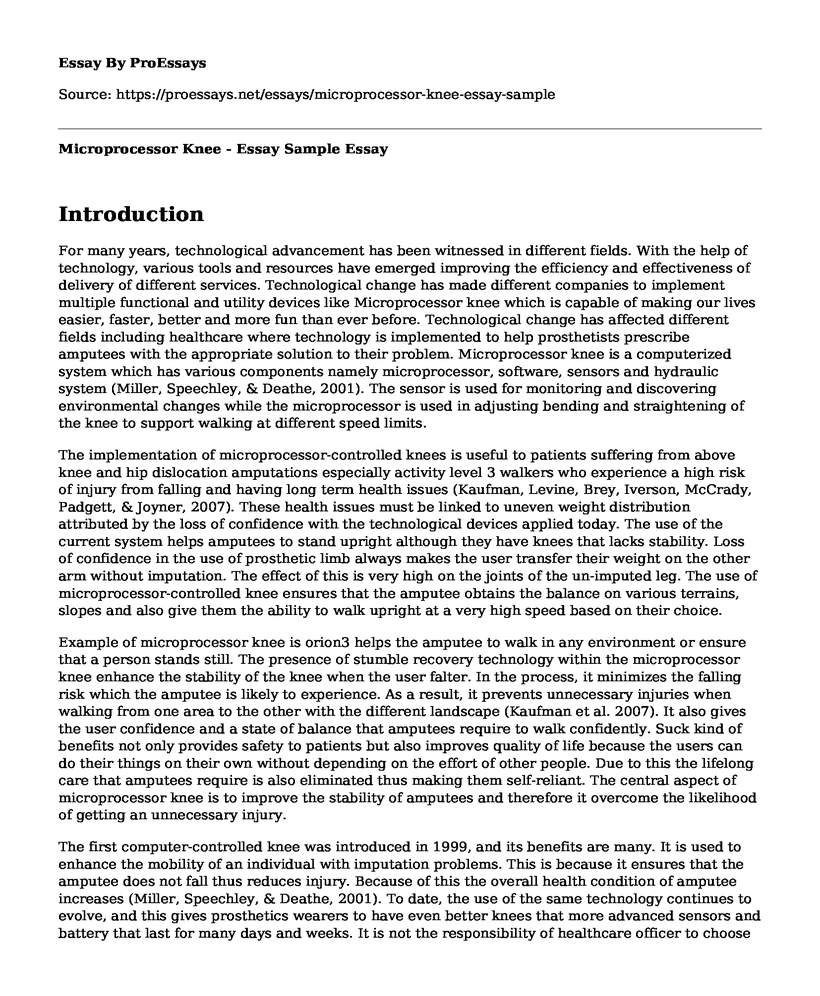Introduction
For many years, technological advancement has been witnessed in different fields. With the help of technology, various tools and resources have emerged improving the efficiency and effectiveness of delivery of different services. Technological change has made different companies to implement multiple functional and utility devices like Microprocessor knee which is capable of making our lives easier, faster, better and more fun than ever before. Technological change has affected different fields including healthcare where technology is implemented to help prosthetists prescribe amputees with the appropriate solution to their problem. Microprocessor knee is a computerized system which has various components namely microprocessor, software, sensors and hydraulic system (Miller, Speechley, & Deathe, 2001). The sensor is used for monitoring and discovering environmental changes while the microprocessor is used in adjusting bending and straightening of the knee to support walking at different speed limits.
The implementation of microprocessor-controlled knees is useful to patients suffering from above knee and hip dislocation amputations especially activity level 3 walkers who experience a high risk of injury from falling and having long term health issues (Kaufman, Levine, Brey, Iverson, McCrady, Padgett, & Joyner, 2007). These health issues must be linked to uneven weight distribution attributed by the loss of confidence with the technological devices applied today. The use of the current system helps amputees to stand upright although they have knees that lacks stability. Loss of confidence in the use of prosthetic limb always makes the user transfer their weight on the other arm without imputation. The effect of this is very high on the joints of the un-imputed leg. The use of microprocessor-controlled knee ensures that the amputee obtains the balance on various terrains, slopes and also give them the ability to walk upright at a very high speed based on their choice.
Example of microprocessor knee is orion3 helps the amputee to walk in any environment or ensure that a person stands still. The presence of stumble recovery technology within the microprocessor knee enhance the stability of the knee when the user falter. In the process, it minimizes the falling risk which the amputee is likely to experience. As a result, it prevents unnecessary injuries when walking from one area to the other with the different landscape (Kaufman et al. 2007). It also gives the user confidence and a state of balance that amputees require to walk confidently. Suck kind of benefits not only provides safety to patients but also improves quality of life because the users can do their things on their own without depending on the effort of other people. Due to this the lifelong care that amputees require is also eliminated thus making them self-reliant. The central aspect of microprocessor knee is to improve the stability of amputees and therefore it overcome the likelihood of getting an unnecessary injury.
The first computer-controlled knee was introduced in 1999, and its benefits are many. It is used to enhance the mobility of an individual with imputation problems. This is because it ensures that the amputee does not fall thus reduces injury. Because of this the overall health condition of amputee increases (Miller, Speechley, & Deathe, 2001). To date, the use of the same technology continues to evolve, and this gives prosthetics wearers to have even better knees that more advanced sensors and battery that last for many days and weeks. It is not the responsibility of healthcare officer to choose the appropriate microprocessor knee that meets his or her needs. There are also the latest technologies that can be used to enhance the stability of amputee, and all these devices can be found in various health centers. The prosthetist must assist the amputee in getting the correct hardware and software that meet the need of every patient.
References
Kaufman, K., Levine, J., Brey, R., Iverson, B., McCrady, S., Padgett, D., & Joyner, M. (2007). Gait and balance of transfemoral amputees using passive mechanical and microprocessor-controlled prosthetic knees. Gait & Posture, 26(4), 489-493. doi:10.1016/j.gaitpost.2007.07.011
Miller, W. C., Speechley, M., & Deathe, B. (2001). The prevalence and risk factors of falling andfear of falling among lower extremity amputees. Archives of Physical Medicine and Rehabilitation, 82(8), 1031-1037. doi:10.1053/apmr.2001.24295
Cite this page
Microprocessor Knee - Essay Sample. (2022, Dec 05). Retrieved from https://proessays.net/essays/microprocessor-knee-essay-sample
If you are the original author of this essay and no longer wish to have it published on the ProEssays website, please click below to request its removal:
- Course Work Sample: ABC Health Care's Income Performance and Budgetary Recommendations
- Essay Sample on Technologies in Healthcare
- Essay on Hypertension & CHF: Metoprolol for Treatment, Prognosis Poor
- COVID-19: From First Cases in China to Global Pandemic - Essay Sample
- Varicella-Zoster Virus: Understanding Immunity & Vaccine Effectiveness - Research Paper
- Strategies for Optimizing Hospital Performance & Safety - Essay Sample
- Essay Example on Assumptions & Biases of Drug Manufacturers: Investigating D'Hooghe's 2017 Study







